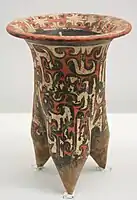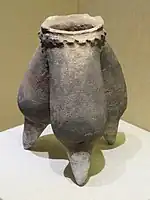.png.webp) -2000 ◁ ▷ General location of the Lower Xiajiadian culture, and contemporary Asian polities c. 2000 BCE | |
| Dates | 2200-1600 BCE |
|---|---|
| Preceded by | Early Neolithic (7000-4500 BCE) Hongshan (4500-3000 BCE) Xiaoheyan (3000-2000 BCE) |
| Followed by | Upper Xiajiadian (1000-600 BCE)[1] |


_and_the_Central_Plains%252C_with_major_sites.png.webp)
The Lower Xiajiadian culture (simplified Chinese: 夏家店下层文化; traditional Chinese: 夏家店下層文化; pinyin: Xiàjiādiàn xiàcéng wénhuà; 2200–1600 BC[3]) is an archaeological culture in Northeast China, found mainly in southeastern Inner Mongolia, northern Hebei, and western Liaoning, China. Subsistence was based on millet farming supplemented with animal husbandry and hunting. Archaeological sites have yielded the remains of pigs, dogs, sheep, and cattle. The culture built permanent settlements and achieved relatively high population densities. The population levels reached by the Lower Xiajiadian culture in the Chifeng region would not be matched until the Liao Dynasty.[4] The culture was preceded by the Hongshan culture, through the transitional Xiaoheyan culture. The type site is represented by the lower layer at Xiajiadian in Chifeng, Inner Mongolia.
Archaeogenetic data shows that "the West Liao River Valley was a contact zone between northern steppe tribes and the Central Plain farming population. The formation and development of the Lower Xiajiadian Culture population was likely a complex process affected by admixture of ethnically different people".[5] The Lower Xiajiadian culture remains displayed high genetic affinity to "Yellow River farmers" but were not identical to them, in contrast, the Upper Xiajiadian remains displayed high genetic affinity to Ancient Northeast Asian Amur hunter-gatherers and later Xianbei.[6] Archaeological and DNA evidence supports examples that the people of the Lower Xiajiadian Culture immigrating to the south and contributed to the gene pool of the Central Plain population during the Bronze Age.[7]
Stone, bone, and pottery artefacts were discovered at Lower Xiajiadian sites, while gold, lead, lacquer, jade, copper, and bronze artefacts are also found. The most commonly found copper and bronze artefacts are dagger-axes with an integrated handle, mace head, piers, knives, and earrings.[8] Mainly small artifacts only were made of bronze, such as dagger and ornaments, with close similarities de the Zhukaigou culture in central Inner Mongolia, or the Qijia culture and the Siba culture in the Hexi Corridor, but major differences from the Erligang culture of the Central Plain.[9] This emerging bronze technology is considered to have been adopted from the Central Asian steppes, and seems to have been key to the introduction of bronze technology into China.[10]
People of the Lower Xiajiadian practiced oracle bone divination. The culture prepared its oracle bones by drilling and polishing the bones before heating them. Inscriptions are generally not found on examples of oracle bones of the Lower Xiajiadian.
People had good access to local sources of stone, primarily basalt, which were often used in construction and tool-making. Lower Xiajiadian houses were typically round, made from mud and stone, and were built with stone walls. Lower Xiajiadian settlements were built near and were protected by cliffs or steep slopes. Stone walls were sometimes erected around the non-sloped perimeter of its settlement. Walls were not thick. Walls with watchtowers and were built by sandwiching a rammed earth core with two sides of stone walls.
There are differing views among Chinese specialists on the origins of the people of the northern part of Lower Xiajiadian culture. One view is that they were perhaps related to the Sushen, who the Shang and Zhou named the non-Chinese people from the Northeast. Another view is that they were the Northern tribal conglomerations, like the Shanrong, Guzhu, Guifang, and Tufang.[11]
Professor Jin Jing-fan (of Jilin University) believes that certain parts of Shang culture has its origins in Dongbei. Along with professors Gan Zhi-geng and Guo Da-shun, they believe that Lower Xiajiadian contributed to some of the origins of both Shang and Yan cultures.[12]
.jpg.webp) Colour-painted pottery pot from the Lower Xiajiadian culture, 2000-1500 BCE. Excavated from Dadianzi, Aohanqi, Inner Mongolia. Capital Museum, Beijing
Colour-painted pottery pot from the Lower Xiajiadian culture, 2000-1500 BCE. Excavated from Dadianzi, Aohanqi, Inner Mongolia. Capital Museum, Beijing Colour-painted pottery pot from the Lower Xiajiadian culture, 2000-1500 BCE. Excavated from Dadianzi, Aohanqi, Inner Mongolia. Capital Museum, Beijing
Colour-painted pottery pot from the Lower Xiajiadian culture, 2000-1500 BCE. Excavated from Dadianzi, Aohanqi, Inner Mongolia. Capital Museum, Beijing Pottery pot from the Lower Xiajiadian culture
Pottery pot from the Lower Xiajiadian culture.jpg.webp) Bronze knife and chisel, Lower Xiajiadian culture
Bronze knife and chisel, Lower Xiajiadian culture.jpg.webp) Bronze axe and chisel, Lower Xiajiadian culture
Bronze axe and chisel, Lower Xiajiadian culture.jpg.webp) Bronze Ding, Lower Xiajiadian culture
Bronze Ding, Lower Xiajiadian culture
See also
Notes
- 1 2 Drennan, Robert D. "Settlement and Social Dynamics in the Upper Daling and Chifeng Regions of Northeastern China".
{{cite journal}}: Cite journal requires|journal=(help) - ↑ Rawson, Jessica (2020). "Chariotry and Prone Burials: Reassessing Late Shang China's Relationship with Its Northern Neighbours". Journal of World Prehistory. 33 (2): 138–168. doi:10.1007/s10963-020-09142-4. S2CID 254751158.
- ↑ Leadership Strategies, Economic Activity, and Interregional Interaction: Social Complexity in Northeast China, pp. 89
- ↑ Leadership Strategies, Economic Activity, and Interregional Interaction: Social Complexity in Northeast China, pp. 120
- ↑ Hongjie Li; Xin Zhao; Yongbin Zhao; Chunxiang Li; Dayong Si; Hui Zhou; Yinqiu Cui (2011), "Genetic characteristics and migration history of a bronze culture population in the West Liao-River valley revealed by ancient DNA", Journal of Human Genetics, Journal of Genetic Health, 56 (12): 815–822, doi:10.1038/jhg.2011.102, PMID 21938002, S2CID 121894
- ↑ Ning, Chao; Li, Tianjiao; Wang, Ke; Zhang, Fan; Li, Tao; Wu, Xiyan; Gao, Shizhu; Zhang, Quanchao; Zhang, Hai; Hudson, Mark J.; Dong, Guanghui; Wu, Sihao; Fang, Yanming; Liu, Chen; Feng, Chunyan (2020-06-01). "Ancient genomes from northern China suggest links between subsistence changes and human migration". Nature Communications. 11 (1): 2700. Bibcode:2020NatCo..11.2700N. doi:10.1038/s41467-020-16557-2. ISSN 2041-1723. PMC 7264253. PMID 32483115.
- ↑ Hongjie Li; Xin Zhao; Yongbin Zhao; Chunxiang Li; Dayong Si; Hui Zhou; Yinqiu Cui (2011), "Genetic characteristics and migration history of a bronze culture population in the West Liao-River valley revealed by ancient DNA", Journal of Human Genetics, Journal of Genetic Health, 56 (12): 815–822, doi:10.1038/jhg.2011.102, PMID 21938002, S2CID 121894
- ↑ Yang, Jianhua; Shao, Huiqiu; Pan, Ling (2020). The Metal Road of the Eastern Eurasian Steppe. pp. 27–28. doi:10.1007/978-981-32-9155-3. ISBN 978-981-32-9154-6. S2CID 213467487.
The bronzes of the Lower Xiajiadian culture include dagger-axes with an integrated handle, mace head, piers, knives, and earrings
- ↑ Li, Chenyuan; Li, Yanxiang; Wang, Lixin; Chen, Kunlong; Liu, Siran (23 September 2019). "Primary research on the bronze technology of Lower Xiajiadian Culture in northeastern China". Heritage Science. 7 (1): 75. doi:10.1186/s40494-019-0314-6. ISSN 2050-7445.
The bronze production technology of the LXC is represented by small artifacts, such as daggers and ornaments [8], and is considered closely related to the Zhukaigou Culture in central Inner Mongolia, and Qijia and Siba Culture in the Hexi Corridor [9], but sharply different from the Erligang Culture in the Central Plain
- ↑ Li, Chenyuan; Li, Yanxiang; Wang, Lixin; Chen, Kunlong; Liu, Siran (23 September 2019). "Primary research on the bronze technology of Lower Xiajiadian Culture in northeastern China". Heritage Science. 7 (1): 75. doi:10.1186/s40494-019-0314-6. ISSN 2050-7445.
The Eurasia steppe is considered as an important region of the introduction of bronze technology into ancient China, and our research is mainly focused on the early bronze cultures at the northern frontier of modern China (...) Although this region is not part of the ancient China proper, the understanding of Bronze Age cultures flourishing in this region could help to explain the origins of metallurgy in China
- ↑ Masataka, Nobuo (2020). The Origins of Language Revisited Differentiation from Music and the Emergence of Neurodiversity and Autism. Springer Singapore. p. 264. ISBN 978-981-15-4250-3.
- ↑ Nelson, Sarah Milledge (1995). The Archaeology of Northeast China - Beyond the Great Wall. Routledge. p. 177-178. ISBN 0-415-11755-0.
References
- Shelach, Gideon, Leadership Strategies, Economic Activity, and Interregional Interaction: Social Complexity in Northeast China, ISBN 0-306-46090-4